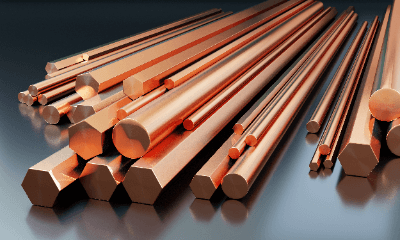What Is Copper?

Copper, with the atomic number 29 and symbol Cu, is widely used in electrical wiring, electronic components, generators, solar cells, and coolers due to its excellent electrical and thermal conductivity. It has a relatively low melting point, allowing for easy molding into various shapes.
Being rust-resistant and chemically stable, copper is highly durable and thus extensively used in construction materials, ships, automobile parts, water pipes, heaters, and coolers. Copper oxide, which forms on its surface, has antibacterial properties, making copper suitable for food processing and medical equipment.
Uses of Copper
Copper is used in various applications, including:
- Electrical and electronic equipment: Wiring, circuit boards, motor and transformer coils, etc.
- Building and construction materials: Exterior walls, roofing materials, building interiors, doorknobs, handrails, etc.
- Automobile and ship parts: Engine parts, cooling system pipes, ship propellers, electrical wiring, etc.
- Medical equipment: Surgical tools and medical equipment surfaces, etc.
- Food processing and cooking utensils: Pots, pans, oven dishes, etc.
- Manufacturing: Copper sheets, machine parts, pipes, building materials, etc.
Types of Copper
There are various types of copper, including alloys:
1. Oxygen-Free Copper
Copper purified by removing oxygen, enhancing its electrical conductivity, making it preferred for electrical wiring and electronic components.
2. Tough Pitch Copper
Strengthened copper containing small amounts of impurities like copper oxide and copper iron, which increase its strength through a fine crystalline structure.
3. Copper Phosphate
Copper treated with phosphoric acid to enhance electrical conductivity and corrosion resistance by removing impurities.
4. Other Alloys
Includes bronze, white copper, nickel silver, brass, aluminum bronze, titanium copper, and chrome copper.
Properties of Copper
1. Thermal Conductivity
One of the best metals for thermal conductivity, copper quickly and evenly transfers heat, reducing temperature disparities.
2. Electrical Conductivity
Excellent at conducting an electric current, copper is vital for efficient transmission in electrical circuits and reduces the loss of electrical signals and power.
3. Nonmagnetic
Pure copper is nonmagnetic due to its atomic structure and electron configuration. However, its magnetism can vary in copper alloys or when impurities are present.
4. Corrosion Resistance
Copper is highly resistant to corrosion and oxidation, attributed to the self-healing oxide film that forms on its surface.
5. Malleability and Ductility
Copper is both malleable and ductile, enabling it to be easily reshaped when heated and to elongate under tensile force due to its crystalline structure.
6. Alloying Capability
Copper readily forms alloys with other metals, such as brass (copper and zinc) and copper-nickel alloys, which have varied properties like electrical and thermal conductivity, corrosion resistance, and strength.
Other Information on Copper
Additional Properties of Copper
Copper also exhibits:
Weldability: Suitable for welding operations due to excellent welding properties.
Wear Resistance: High resistance to friction and wear.
Low Friction Properties: Low frictional resistance, reducing the need for lubricants or grease.
Heat Resistance: Performs well in high-temperature environments and processes.
Antibacterial Properties: Inhibits the growth of bacteria and viruses on its surface.
Recyclability: Easily recycled from waste and end-of-life products.
Aesthetics: Attractive bright reddish hue.
Magnetic Field Permeability: High magnetic field permeability, useful in electromagnetic devices, but lower than other magnetic materials like iron or cobalt.